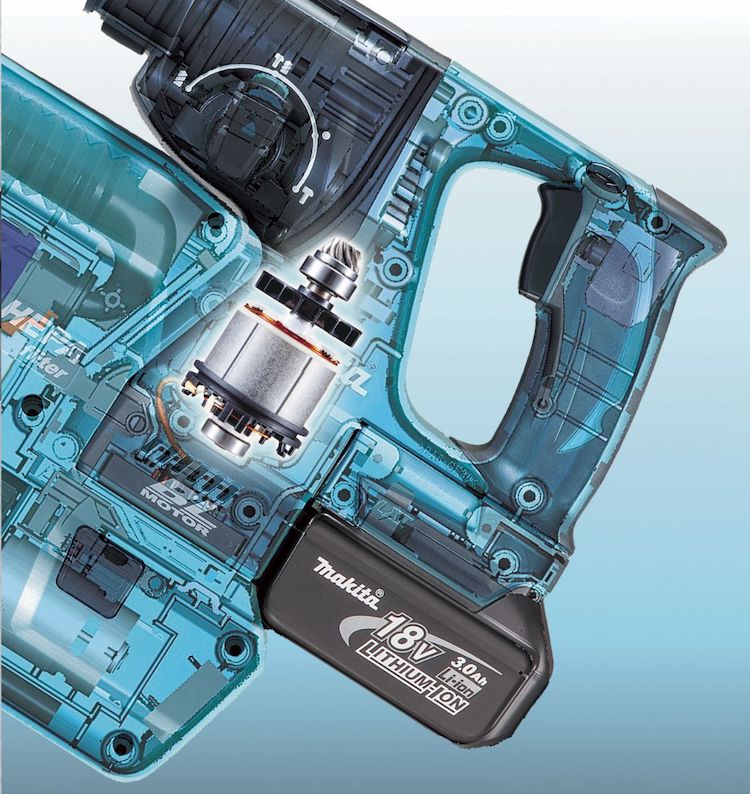We may earn revenue from the products available on this page and participate in affiliate programs. Learn More ›
Often, two power tools from the same manufacturer will have very similar specifications. The only clear difference may be that one has a brushed motor and the other has a brushless version. The latter is invariably more expensive, so the big question is whether brushless power tools warrant that additional cost.
We have put together a concise explanation that focuses on both types and the relevant pros and cons of each. The following clarifies the brushless vs. brushed motor debate to help you make the best choice in terms of performance and value.
Brushless motors are more applicable to cordless tools than corded versions.
The subject of brushed and brushless motors appears to cover two types at first glance. In reality, there are actually four motor types. There are brushless AC motors, brushed AC motors, brushless DC motors, and brushed DC motors.
Alternating Current (AC) is what comes out the wall socket, so all corded power tools must have AC motors. The vast majority are brushed motors, a proven design that has been around for generations. Brushless AC motors do exist, but the main benefits of this type of motor are more appropriate for cordless tools. When they are used, brushless AC motors tend to be found on heavy-duty professional tools.
Direct Current (DC) is what batteries supply, and it’s used in every cordless tool. As with AC motors, battery-powered tools can use either a brushed or brushless DC motors (the latter is also known as BLDC). Both types are widely available, so cordless tools are where most questions about brushless vs. brushed motors arise.
Related: The Best Power Tool Sets for Your Needs and Budget, Tested
How does a brushed motor work?
The main components of a brushed motor are housed in an outer shell containing permanent—or stator—magnets. Inside this shell is a series of wire coils called an armature. Running through the middle of the armature is a drive shaft (or rotor) that delivers the mechanical drive. A brushed motor also has a commutator on the end of the armature.
As electricity passes through the armature, the armature becomes magnetic. If the polarity of that magnetism is the same as the permanent magnet, then it is repelled, making the armature turn. The central rotor turns with it, which provides drive to the chuck, saw blade, etc. However, when the armature turns halfway around, the polarities will be opposite. Because opposite polarities attract, the motor should stop.
To prevent this and keep the motor running, brushes are fitted that rub against the commutator. One brush carries a positive charge, the other negative. They deliver continuously changing polarity to the armature so it continues to be repelled. As a result, the motor carries on spinning.

How does a brushless motor work?
So what is a brushless motor, and what does brushless mean? A brushless motor still contains a stator, armature, and rotor, but it has no physical commutator. As the name suggests, it doesn’t contain any brushes either.
These parts are replaced by an electronic circuit called an inverter. This produces a single, continuously revolving magnetic field around the armature to create constant motion. This type of motor therefore needs neither the physical contact of brushes or the associated commutator.
Related: Proceed With Caution: 12 Power Tools That Can Kill You
Brushless motors are more energy efficient.
Brushed motors’ brushes cause friction, meaning that some of the energy they supply is used to overcome that friction. Friction also causes loss of voltage, which reduces the amount of energy driving the tool.
Brushless motors lack friction from brushes; therefore, they turn much more of the electricity produced into usable energy. This is particularly important for battery-powered tools, which have a finite amount of power available per charge. A brushless drill, for example, might run anywhere from 30 to 50 percent longer than the same cordless drill fitted with a brushed motor.
There are other advantages to brushless motors. The lack of drag or associated heat build means brushless motors can reach the desired speed more quickly than their brushed counterparts, run faster for longer, and (usually) deliver more torque for the equivalent power consumption.
Brushed motors require more maintenance than brushless motors.
Brushes rubbing against brushed motor commutators causes them to eventually wear out. Obvious signs of this are a stuttering motor, or a power tool that stops and starts erratically. Replacing brushes isn’t technically complicated and the parts are usually available, but power tool manufacturers don’t always make it easy to access a given tool’s motor. At the very least, it is inconvenient.
Eventually, commutators can also wear out, and the construction of a motor may not make replacement feasible. Even if it is practical, the price of spare parts might make it cheaper to simply buy a new tool altogether. This is especially true with budget models, which are more likely to use brushed motors.
By contrast, brushless power tool motors have no replaceable parts and are therefore maintenance-free. They also tend to have a significantly longer working life.
Related: We Tested the Best Oscillating Tools, See Our Top Picks

Brushless motors are more compact and run quieter than brushed motors.
The lack of commutators in brushless motors can save a lot of space. Brushless drills in particular can be made very compact. This also means that when the physical size of the power tool isn’t much of a concern, a larger and more powerful motor can be used. For example, typically power-hungry tools like rotary hammer drills can be given increased performance while retaining similar dimensions to brushed motor equivalents.
The lack of friction and associated vibration also makes brushless tools run more quietly. While this isn’t particularly noticeable with drills/drivers, jigsaws, and sanders, it can make a significant difference for tools like circular saws and planers. The reduced vibration also helps make tools like rotary hammer drills more comfortable to use for longer periods.
Safety is also a factor to consider. Brushed motors can cause sparks, especially as the brushes wear and contact grows inconsistent. In some environments, this friction might present a fire hazard or risk of explosion. While other precautions may need to be taken, brushless motors do not create sparks, making them a much safer option.
Brushed motors cost less than brushless motors.
At this point, everything seems to point toward brushless motors as the clear winner. However, a brushless motor may not always be the better choice.
Brushed motors have been around for generations, so they’re reliable and much less expensive than brushless motors. When it comes to choosing between a brushless or brushed drill, the latter might offer very similar features and comparable performance for as little as half the price. The same can also be true for other types of power tools.
For the professional, brushless tools’ ability to run longer and minimal maintenance requirements might provide a major advantage. However, those elements usually have less impact on the DIY user. It might not matter if work needs to be stopped to charge a battery. If a tool is not used very often, they might never wear out a set of brushes. As a result, the maintenance factor becomes less significant. If a brushed tool isn’t used all day, every day, the fact that it’s a little noisier might not be as relevant.
For those who need high performance and durability on the jobsite, a brushless motor has clear advantages. In the long-term, it will likely prove to be a better investment. However, if you’re looking for a bargain, a cordless power tool with a brushed motor is well worth considering.


